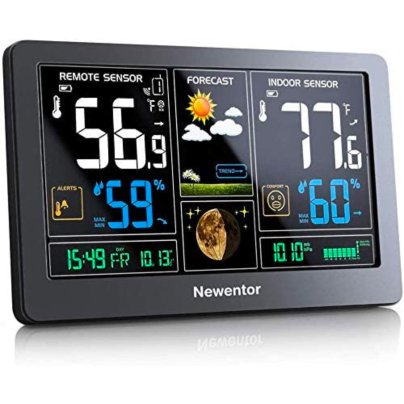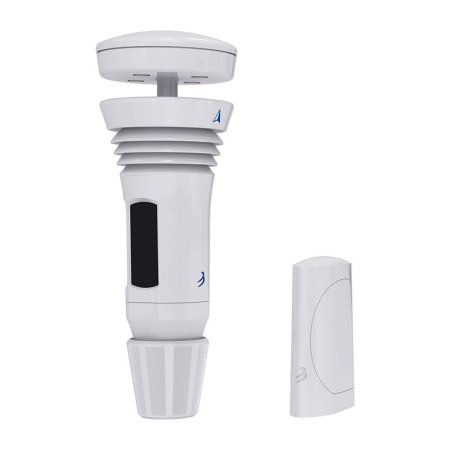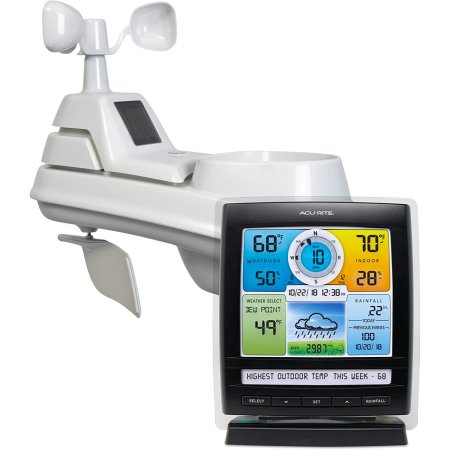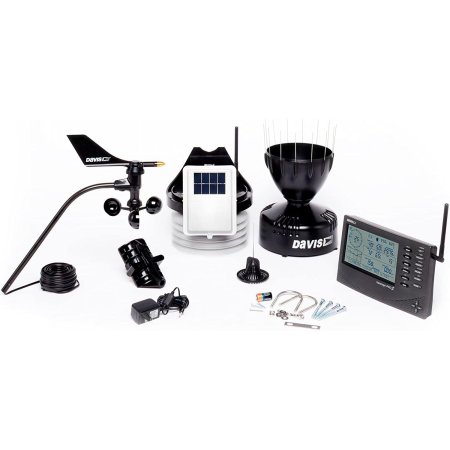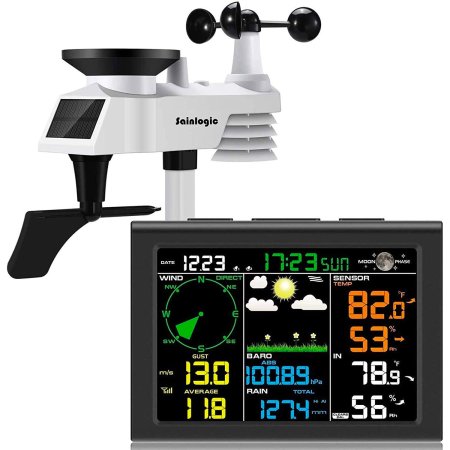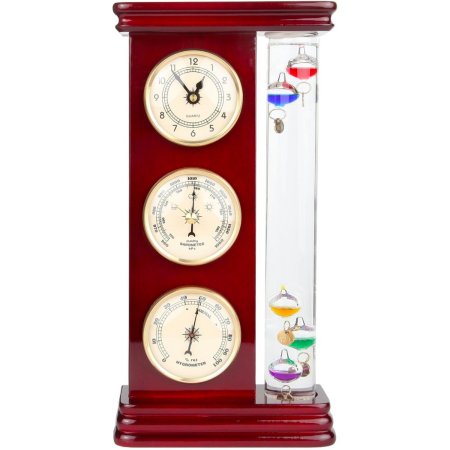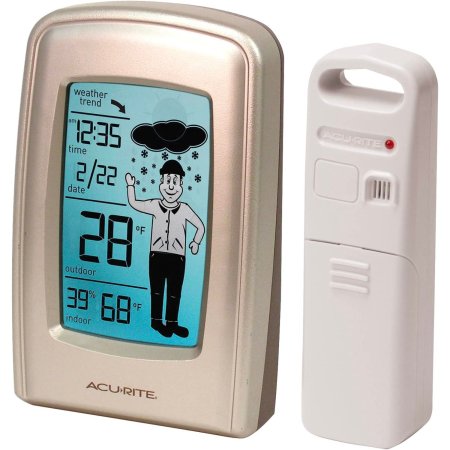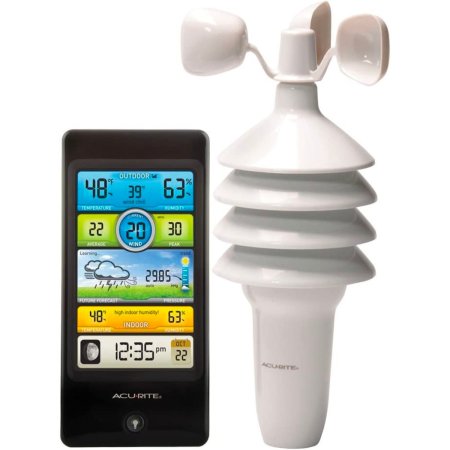
We may earn revenue from the products available on this page and participate in affiliate programs. Learn More ›
Home weather stations are highly convenient, tipping you off to temperature, rainfall, and other elements before you venture outside. We tested a variety of home weather stations to help you find the best one for your needs, and our top pick is the Ambient Weather WS-2902C. During testing, this model impressed us with its accuracy, ease of setup, and ability to connect to Wi-Fi and weather servers like Weather Underground.
We also interviewed broadcast meteorologist Cheryl Nelson, owner of Prepare With Cher. Some shoppers may be surprised to learn that there are gaps between official weather reporting stations. “There are numerous microclimates [across the US], meaning that the weather can vary—sometimes significantly—within a few miles of separate locations.” To solve this, an at-home weather station can fill those gaps to provide users with the best data for their immediate area.
Keep reading to learn which features to look for when choosing a weather station and discover why the following products are well suited for various weather-reporting tasks. Find out what our hands-on testing revealed, then weigh the pros and cons to choose the best home weather station.
- BEST OVERALL: Ambient Weather WS-2902C WiFi Home Weather Station
↓ Jump to Review - RUNNER-UP: WeatherFlow Tempest Smart Home Weather System
↓ Jump to Review - BEST BANG FOR THE BUCK: Newentor Q3 Wireless Atomic 7.5-Inch Weather Station
↓ Jump to Review - BEST MIDRANGE: AcuRite Iris 5-in-1 Home Weather Station
↓ Jump to Review - MOST ACCURATE: Davis Instruments 6152 Vantage Pro2 Weather Station
↓ Jump to Review - BEST DISPLAY: Sainlogic 8-in-1 Wireless Weather Station
↓ Jump to Review - BEST LOW-TECH: Lily’s Home Analog Weather Station
↓ Jump to Review - BEST FOR KIDS: AcuRite 00827 What-to-Wear Weather Station
↓ Jump to Review - ALSO CONSIDER: AcuRite Notos 3-in-1 Home Weather Station
↓ Jump to Review
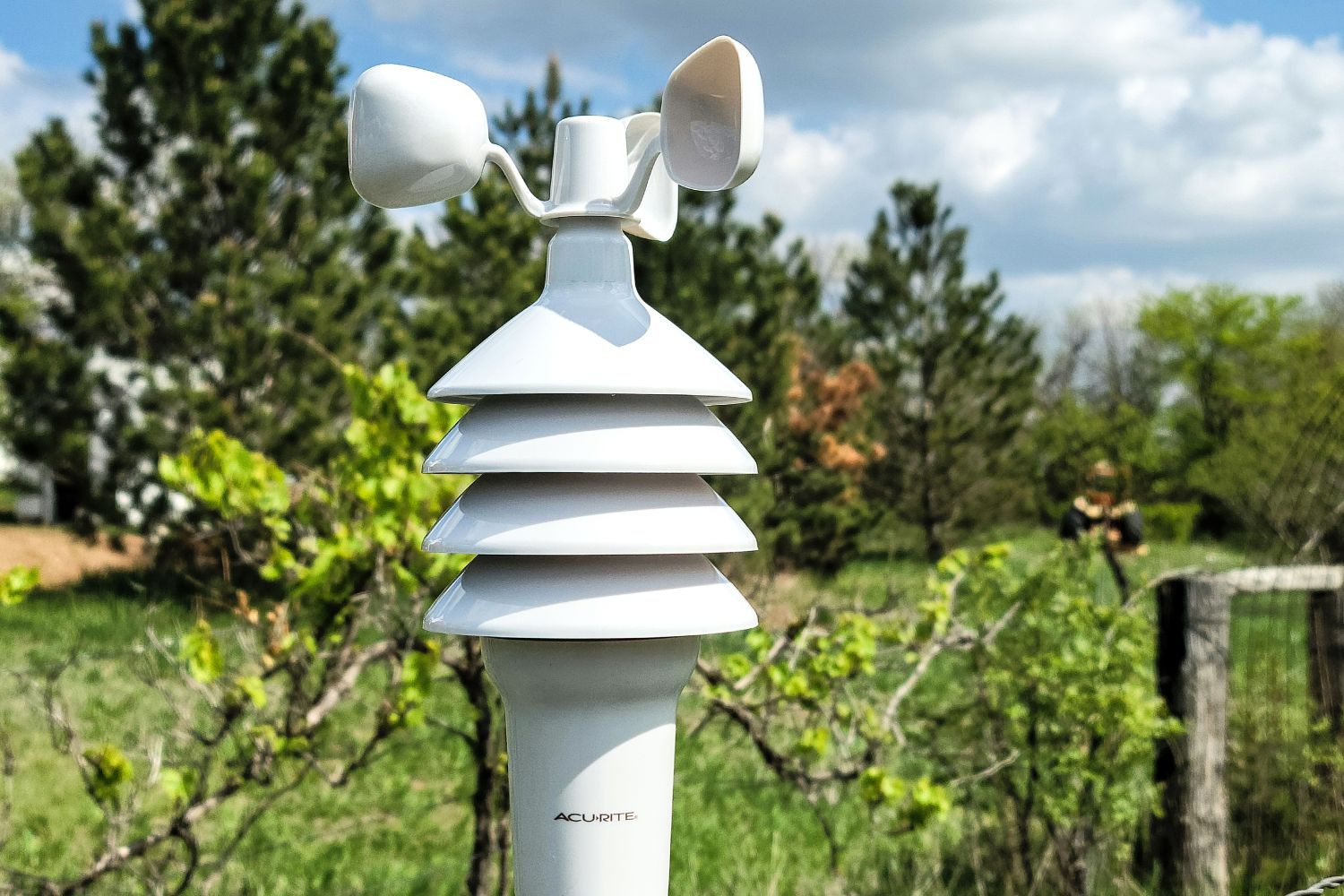
| Testing Stats | |
|---|---|
| Products tested | 10 |
| Time spent testing | 2 months |
| Tests performed | 2-6 |
| Price range | $35-$770 |
Our Top Picks
To qualify for inclusion in this lineup of the best home weather stations, the following models had to be installed with relative ease. (Hooking up the Wi-Fi versions is more complex and requires a working knowledge of home networks and routers.) Each model had to be accurate and present data in an easy-to-access fashion. The following home weather stations run the gamut in price and features, but they all excelled in our hands-on tests, and each one is a standout in its own category.
Best Overall
Ambient Weather WS-2902C WiFi Home Weather Station
What We Like
- Amazon Alexa-compatible voice control and hands-free operation
- Solar-powered, providing an eco-friendly and cost-effective energy source
- Wi-Fi remote access for convenient monitoring from anywhere
- Provides multiple readings, including temperature, humidity, and more
What We Don’t Like
- Backup batteries not included with purchase
Product Specs
- Wi-Fi capable: Yes, 2.4 GHz required
- Power source: Solar-powered array with battery backup
- Weather conditions monitored: Wind speed and direction, temperature, rainfall, barometric pressure, humidity, windchill, heat index, UV ray intensity
For a home weather station that goes above and beyond, consider this Alexa-compatible model from Ambient Weather. In addition to the basics like temperature, date, time, and precipitation, the WS-2902 shows wind speed and direction, humidity, UV and solar radiation, heat index, wind chill, and dew point on its easy-to-read LCD display. Because it’s solar-powered with backup battery power (AAA batteries not included), users needn’t worry about losing power.
In terms of remote access, the WS-2902C can transmit data over the internet with Wi-Fi connectivity. The sensor has seven different points to measure the elements accurately (mounting pole not included).
The Ambient Weather’s user manual details every connection step. After assembling the sensor array outdoors, we powered up the indoor console and followed the directions to sync it to the array. We mounted the weather station on a pole, then manually set the date and time. This is a WiFi-compatible model, and easily synced with our home wireless network.
We used a compass app to orient the weather station to true north to record accurate wind direction. After setup, we collected the data (wind speed, direction, and windchill) and compared it with the data from a nearby official weather station. The Ambient Weather array closely matched.
What our tester says: “This weather station is straightforward to install, produces accurate weather data, and allows you to publish local weather data online.” — Glenda Taylor, Bob Vila writer and product tester
Get the Ambient Weather home weather station at Amazon, Wayfair, Ambient Weather, or Walmart.
Runner-Up
WeatherFlow Tempest Smart Home Weather System
What We Like
- Measures multiple weather conditions accurately
- Setup is easy with user-friendly and intuitive app
- Smart-home integration for seamless monitoring
- Sleek, modern design with reliable performance
What We Don’t Like
- High winds may skew rainfall data accuracy
Product Specs
- Wi-Fi capable: Yes
- Power source: Solar-powered array with battery backup
- Weather conditions monitored: Wind speed and direction, temperature, rainfall, barometric pressure, humidity, UV ray intensity, lightning strikes
Right out of the box, the WeatherFlow Tempest was impressive. While the other WiFi-capable weather stations we tested use a weather vane or an anemometer, the Tempest’s advanced design incorporates those features into its cutting-edge cylindrical array. It has no moving parts whatsoever, so at first, we thought it wouldn’t be capable of accurately measuring rainfall. We were wrong.
The Tempest uses a haptic rain sensor that measures rainfall by vibration rather than volume. The instruction manual suggests comparing rainfall totals with another nearby gauge, so we used our Davis Instruments Vantage Pro2 (see above) as the comparison model. We compared its data with our Davis Instruments Vantage Pro2, which reported 0.24 inches against the Tempest’s 0.22 inches, showcasing its accuracy, though the manufacturer cautions that high wind speeds can affect readings.
Like other Wi-Fi arrays that measure wind direction, the Tempest requires orientation to true north, which is made easier by an arrow on the unit. It uses an ultrasonic anemometer to detect and measure wind speed.
Added sensors for detecting nearby lightning, UV ray intensity, and ambient light are unique to the Tempest. However, it lacks an indoor display console, requiring us to download the app for setup and sync with our smartphone and router. The app was user-friendly and glitch-free.
We also connected it to Alexa for voice commands, allowing us to check wind speed conveniently. Additionally, we could publish data to online weather services like Weather Underground.
What our tester says: “The Tempest is just the ticket for those who enjoy home weather devices with advanced innovative technology.” — Glenda Taylor, Bob Vila writer and product tester
Get the WeatherFlow home weather station at Amazon or WeatherFlow.
Best Bang for the Buck
Newentor Q3 Wireless Atomic 7.5-Inch Weather Station
What We Like
- Offers an affordable option for tight budgets
- Simple, user-friendly interface for easy navigation and use
- Large, easy-to-read, 7.5-inch display screen ideal for outdoors
What We Don’t Like
- Not rain- or sunproof; must keep covered
PProduct Specs
- Wi-Fi capable: No
- Power source: Battery and plug-in
- Weather conditions monitored: Temperature, humidity
Those with large yards or multiple outdoor spaces to monitor should consider this home weather station from Newentor. With the ability to connect to three different outdoor sensors (only one is included), it can monitor temperature and weather conditions in multiple areas at once. Sensors should not be placed in direct sunlight or exposed to precipitation—under a protected eave is a good location.
This home weather station’s large, colorful, easy-to-read display shows both the outdoor and indoor temperature as well as humidity, time and date, moon phase, barometric pressure, and forecast. It offers a USB port for charging devices and the ability to customize alerts. The frost-alert function calculates temperature and humidity levels to predict when frost will occur.
Setting up the Newentor is quick and straightforward. We inserted two AA batteries into the outdoor sensor unit and plugged them into the display console. Within seconds, the sensor was transmitting data. The Newentor transmission range is advertised as “up to 200 feet,” but in our tests, it exceeded that, and we could transmit data up to 220 feet. Its temperature and humidity readings were both accurate.
The Newentor offers a weather forecast based on barometric pressure for the next 12 to 24 hours. While not as accurate as professional services, it’s useful for daily planning. This atomic model also quickly displays the time, date, and moon phases.
What our tester says: “This is a simple but fun weather monitor for those who want accurate readings without the extra fuss of a wireless model.” — Glenda Taylor, Bob Vila writer and product tester
Get the Newentor home weather station at Amazon or Newentor.
Best Midrange
AcuRite Iris 5-in-1 Home Weather Station
What We Like
- Large and easy-to-read display
- Provides comprehensive and accurate precipitation data
- Measures precise wind data
What We Don’t Like
- Mounting holes are undersized; they may require drilling
Product Specs
- Wi-Fi capable: No
- Power source: Solar-powered array with battery backup; battery-powered console
- Weather conditions monitored: Wind speed and direction, temperature, rainfall, barometric pressure, humidity
This solar-powered weather station measures temperature, featuring one the best indoor thermometers measures, wind speed and direction, rainfall, and humidity. It displays the forecast, moon phase, and “feels like” temperature indoors, along with actual indoor and outdoor temperatures and humidity. While it’s a basic model without Wi-Fi, it provides historical data on high and low temperatures and weekly rainfall. Its sensor can be placed in direct sunlight, and it features self-emptying cups for rainfall measurement.
After inserting batteries in both the sensor array and the display console (eight AA batteries total, although an optional AC plug is included), we tested the Bluetooth range of the AcuRite Iris by having one person hold the array and walk away while the other person monitored the display. At just over 120 feet, the console stopped receiving a signal—hardly the 330 feet advertised, but still a decent range.
We then mounted the AcuRite Iris and leveled it using the handy bubble level on the top. After orienting the array to true north using a surveying compass, we compared temperature, humidity, wind speed, and wind direction data to that of the nearby official weather station, and the results were good.
One pesky downside to the AcuRite Iris is the undersized holes in the mounting base that accommodate very narrow screws. Since no screws came with the unit, that meant a trip to the hardware store. However, this is a nice little Bluetooth weather station with an impressive enhanced display console.
Get the AcuRite Iris home weather station at Amazon or Walmart.
Most Accurate
Davis Instruments 6152 Vantage Pro2 Weather Station
What We Like
- Frequent updates every 2.5 seconds and 1 minute
- Measures windchill, heat index, and more
- Durable, long-lasting rugged design
What We Don’t Like
- Hub and software sold separately
- Higher pricepoint with add-ons
Product Specs
- Wi-Fi capable: Yes
- Power source: Solar-powered array with battery backup; battery-powered/plug-in console
- Weather conditions monitored: Wind speed and direction, temperature, rainfall, barometric pressure, humidity, dew point, windchill, heat index
This rugged system can withstand virtually any environment and report with great accuracy. The solar-powered wireless home weather station updates every 2.5 seconds to provide up-to-date weather information. It measures both indoor and outdoor temperature as well as humidity, barometric pressure, wind, rain, dew point, heat index, and windchill. Additional sensors, including those for soil moisture and UV intensity, are sold separately. Like other arrays that monitor wind direction, the Vantage Pro2 must be set with a reliable compass.
We purchased and installed this weather station a few months before testing the others in this lineup and found that the Davis Instruments Vantage Pro2 lives up to its reputation for accuracy. We mounted it on a permanent tower that we set in a concrete base to ensure the best results. We also purchased the corresponding hub and data-logging software to create an online weather account.
In the months since we installed the Vantage Pro2, it’s given us accurate readings, and we’re publishing data to several online weather services, including Weather Underground and Personal Weather Stations (PWS). After noticing a rainfall discrepancy, we found birds had perched on the unit, affecting the rain collector. Adding the included bird spikes solved the issue.
The Vantage Pro2 has a truly impressive transmission range, advertised as being up to 1,000 feet. Ours is located just over 550 feet away, and we receive a strong signal. Ideal for dedicated weather enthusiasts, the Vantage Pro2 offers data sharing and historical storage options.
Get the Davis Instruments Vantage Pro2 home weather station at Amazon, Walmart, WeatherShack, or Davis Instruments.
Best Display
Sainlogic 8-in-1 Wireless Weather Station
Pros
- Measures multiple weather points, including temperature, humidity, and barometric pressure
- Provides frequent and accurate updates for reliable and up-to-date weather tracking
- Durable and rugged design to withstand harsh weather conditions
Cons
- Does not support Wi-Fi, making it unable to send weather data to a smartphone or tablet
- Console’s screen is on the small side, which could be an issue for those with visual impairments
Product Specs
- Wi-Fi capable: No
- Power source: Solar-powered array with battery backup; battery-powered console
- Weather conditions monitored: Wind speed and direction, temperature, rainfall, barometricpressure, humidity, dew point
The Sainlogic wireless weather station accurately monitors weather conditions and transmits data using Bluetooth technology. While this weather station resembles models that feature Wi-Fi capability, the Sainlogic will not connect to a home network, so data cannot be uploaded to an online weather service. However, for a Bluetooth-only array, the Sainlogic is accurate and comes with multiple sensors that monitor outdoor temperature, indoor home temperatures, wind speed and direction, rainfall accumulation, and barometric pressure.
We checked the transmission range of the array and found it could accurately transmit data just over a 250-foot distance. We mounted the station and used a surveying compass to orient it to true north. The Sainlogic uses a traditional anemometer and weather vane to measure wind, and its data was comparable to the data of our larger weather station.
The display console is atomic; we just plugged it in, and it quickly lit up and displayed the correct time, indoor temperature, humidity, and moon phase. After a few minutes, it registered wind speed and direction. The console offers multiple functions, including programming alerts for wind gusts, dew point, temperature, and humidity. The alarm is loud, but at just 5 inches long by 4 inches wide, the display is difficult to see from across the room.
Get the Sainlogic home weather station at Amazon or Sainlogic.
Best Low-Tech
Lily’s Home Analog Weather Station
What We Like
- Colorful spheres for unique temperature measurement
- Precision quartz clock provides accurate timekeeping
- Includes analog hygrometer and barometer
What We Don’t Like
- Galileo thermometer may lack accuracy of digital thermometers
- Barometer needs initial and periodic calibration
- No Bluetooth or Wi-Fi connectively or alerts
Product Specs
- Wi-Fi capable: No
- Power source: N/A
- Weather conditions monitored: Temperature, barometric pressure, humidity
We tested the Lily’s Home analog model and found that while it lacks precision, it has a unique charm and practicality. This manual weather station comes with an analog barometer, hygrometer, and Galileo thermometer, named after the famed Italian physicist Galileo Galilei.
We tested the barometer by calibrating it to match our Davis Vantage Pro2, and it remained consistently accurate. The hygrometer showed slight variance, typically reading 0.5 to 1 point lower, which is a good range for an analog device.
To test the Galileo thermometer (a glass cylinder with floating bulbs that indicate temperature) we first had to learn how to read it. Each bulb has a different density, and the bulbs rise and fall as the temperature changes. The lowest floating bulb(s) in the cylinder indicates the temperature in the room. The tags represent 64, 68, 72, 76, and 80 degrees Fahrenheit.
In a cool basement at 62°F, all bulbs floated to the top, showing the room was below 64°F. When warmed with a hair dryer, the bulbs sank, indicating over 80°F. At 70°F, the 68°F and 72°F bulbs floated together, matching the room temperature accurately. Overall, the measurements were generally within 1 to 3°F of the digital readings, especially at higher temperatures. We were impressed with the accuracy of the Galileo thermometer, given that it’s a technology that’s been around for centuries.
Overall, we think the Lily weather station would make an excellent educational tool for kids or anyone interested in learning about fluid dynamics and thermodynamic principles. Besides being practical, it is visually attractive and adds character to any room.
Get the Lily’s Home weather station at Amazon or Bits and Pieces.
Best for Kids
AcuRite 00827 What-to-Wear Weather Station
What We Like
- Educational tools for learning about weather
- Easy-to-read display shows current weather and attire
- Fun and interactive science engagement for kids
What We Don’t Like
- Limited data compared to other weather stations
- “What-to-wear” feature may feel impractical
Product Specs
- Wi-Fi capable: No
- Power source: Battery-powered
- Weather conditions monitored: Temperature, humidity
Trying to decipher the numbers and symbols on standard weather station displays can be challenging for small children—but images of a friend standing in the sunshine, under a storm cloud, or bundled up with snowflakes flying make the What-to-Wear station pretty easy to understand. The display features the image of a boy in attire that changes with the weather, making it easy for kids to know how to dress for going outdoors.
We inserted two AA batteries in the display unit and two more in the remote sensor, then checked the temperature and humidity levels against our Davis Vantage Pro2. Temperature matched closely, though the humidity was off initially. We realized it only reads indoor humidity, which was affected by air conditioning. When moved outside, it was within one degree of the Davis reading.
Setting up this digital weather station was simple. There are buttons to select date and time, and calibration took two days as recommended. We tested various temperatures and the image of the boy changed accordingly. When the sensor was cold, the little boy donned long pants, a coat and hat, and a scarf around his face. When the temperature was hot, he wore shorts and a T-shirt.
The display doesn’t list a barometric pressure reading, but the boy’s changing outfit reflects it. On one stormy day, the display showed a dark thundercloud that flashed—a sign of severe thunderstorms. This is a cute little weather station designed for kids, but even as adults, we thought it was fun to see our weather friend’s clothing change.
Get the AcuRite What-to-Wear home weather station at Amazon, Jack’s Country Store, or Walmart.
Also Consider
AcuRite Notos 3-in-1 Home Weather Station
What We Like
- Measures temperature, humidity, and wind speed
- Easy-to-read digital display for quick weather updates
- Durable, weather-resistant design for long-lasting performance
What We Don’t Like
- Lacks rainfall measurment, limiting weather-tracking capabilities
Product Specs
- Wi-Fi capable: No
- Power source: Battery-powered
- Weather conditions monitored: Wind speed, temperature, barometric pressure, humidity, dew point, windchill, heat index
The AcuRite Notos 3-in-1 weather station is reliable and user-friendly, offering outdoor temperature, humidity, wind speed, heat index, and windchill readings. Though it lacks Wi-Fi connectivity, it provides many essential weather metrics.
Invest in a large pack of AA batteries because the weather station takes four, and the display unit uses two, which are not included. We found the color display easy to read, providing a clear overview of the current weather conditions and a forecast based on internal barometric pressure readings. This is a self-calibrating unit, but for the sensor to communicate with the base display, we had to set interior switches in the sensor and the display to the same setting. We tried all three settings, with consistent signal strength across switches A, B, or C.
After initial power-up, readings took an hour to appear, with full calibration completed in 14 days. When compared to the Davis Vantage Pro2, the Notos had slightly lower wind speed readings, likely due to height differences in mounting. The temperature readings were very close every time we checked them.
One of our favorite features was the “what-it-feels-like” reading, giving a better sense of outdoor conditions. Other fun features include a wind speed history and a moon cycle display. We could get readings between the display and the sensor up to 250 feet apart.
All in all, this is a nice little weather station—a midrange model for someone who wants accurate readings but isn’t interested in a Wi-Fi model. The only downside for us was the lack of rainfall readings.
Get the AcuRite Notos home weather station at Amazon, The Home Depot, Blain’s Farm & Fleet, Tractor Supply Co., or AcuRite.
Jump to Our Top Picks
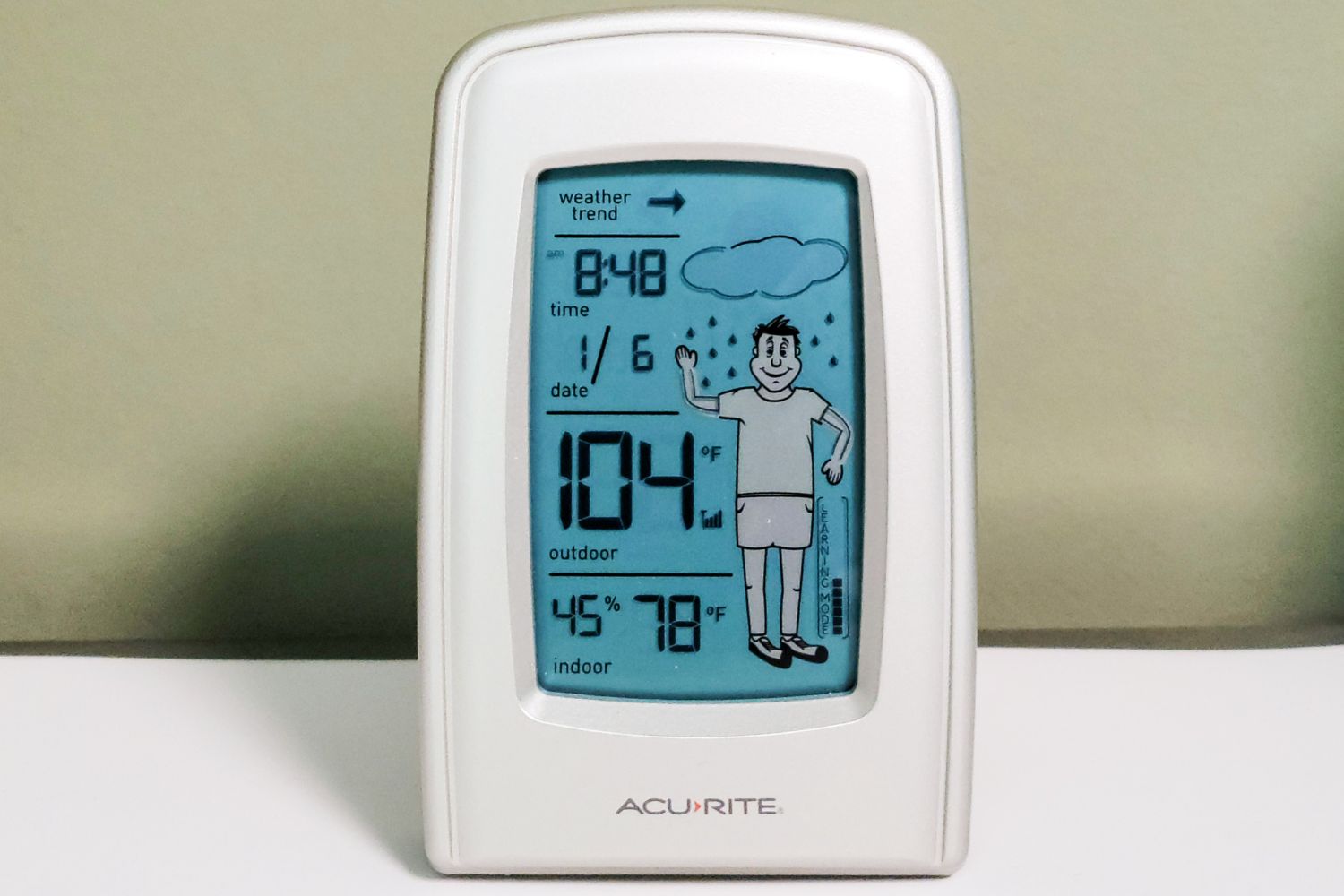
How We Tested the Best Home Weather Stations
To recommend the best weather stations for home, we tested a group of products to find those that provided accurate data and lived up to manufacturers’ claims. We tried every function each weather station offered and awarded points based on performance, durability, and accuracy. To qualify the data, we compared it to a nearby official weather station and our own Davis Instruments Vantage Pro2 weather station.
For models that record wind direction, we mounted the units outdoors and oriented them to true north using a survey compass. You could try doing this using a compass app on a smartphone, but we didn’t have much success with that method.
We went a step further with weather stations with Wi-Fi connectivity by syncing them to our wireless home network and then uploading the data to online weather services. For each unit, this required establishing an individual account with the service.
We noted the overall quality of the materials and tested the transmission distance. Most household weather stations did not meet the manufacturer’s advertised distance, but one exceeded it. Still, we found the range of all models in this lineup adequate.
Manufacturer reputation was also considered. Davis Instruments weather stations are well known for their accuracy, and many are used by severe weather enthusiasts who upload data to the internet. But we also looked at smaller, less-known manufacturers who make high-quality units with a variety of weather-monitoring options.
Before testing, Nelson also gave us expert advice on installing a home weather station. To avoid inaccurate readings due to warmer air temperatures close to pavements/traffic, “don’t place them too low to the ground near the blacktop/pavement.” We kept this in mind during our hands-on testing.
What to Consider When Choosing a Home Weather Station
If you want to know the recent rainfall total in your garden or whether you should grab a warmer jacket before heading out for the day, a home weather station can quickly and accurately give you information to help you plan your day’s activities. When shopping for one, keep in mind the power source, functions, accuracy, display, and other considerations, all detailed below.
Power Source
A home weather station’s power source is essential for its function. Many are wireless, running on solar or battery power, which lets you place the station virtually anywhere without the need for a nearby electrical outlet. Solar-powered units (which typically have a backup battery as well) absorb and transform sunlight into power to run the weather station while charging the backup batteries. Most solar-powered weather stations don’t require high levels of direct sunlight, but they do need some, so select a spot in the yard where the unit will receive an average of 2 to 6 hours of sunlight per day.
Functions
While nearly all good weather stations for home report temperature, precipitation, and humidity, some have extra features that detail the heat index, windchill, moon phase, solar radiation, and sunrise/sunset times. Consider your priorities to determine if these readings would be worth knowing—and paying for.
Accuracy
Several factors can influence the accuracy of a home weather station, including the placement of the device and how often it takes measurements throughout the day. A home weather station’s materials and construction can also affect its accuracy. For instance, some models with plastic-covered sensors tend to overheat and give false readings, while those with a protective shield or fan help mitigate inaccuracy. Once you choose a home weather station, make sure to follow setup instructions specific to the product to ensure the readings will be as accurate as possible.
Display
The display on a home weather station model should provide at-a-glance information that’s easy to read and manage. Consider the size of the display console: Will household members require a larger display for easy readability, or would you prefer something more compact or discreet?
Sensor Range
Home weather stations employ a variety of sensors—small devices that detect and measure weather conditions—such as temperature, humidity, barometric pressure, and UV intensity. These sensors, which vary from unit to unit, are located on the part of the weather station that’s kept outdoors, which is generally known as the “array.” The array’s sensor range indicates how far the sensors can transmit data to a receiving unit, such as a display console, hub, or wireless router. The average sensor range is about 100 feet, but some models can deliver accurate readings from 300 or even 1,000 feet away.
Weather station manufacturers typically denote their product’s outdoor weather sensor range from the array to the receiving unit without making allowances for objects between the two points, such as walls or trees. The actual sensor range can vary depending on the number of objects that lie between the two points. For example, a weather station with a sensor range of 300 feet may only be able to transmit data up to 100 feet if multiple walls, trees, and hedges lie between the array and the receiving unit.
Remote Access
Remote access enables you to view weather station readings from anywhere via smartphone, tablet, or computer. Depending on the unit, it may also allow you to view current and previous weather data, along with any alerts. Typically, this is done through a brand-specific app. Remote access doesn’t come standard on all home weather stations, so check the product information if this feature is important to you.
Smart Technology
In addition to remote access, consider compatibility with smart-home technology such as Amazon Alexa, Google Home, and other programs and apps to access weather information remotely or by using voice commands. Syncing with an app and a home wireless network lets you access weather station data via a smartphone—very convenient when at work, on vacation, or otherwise away from home. This technology can also be useful if you have additional smart-home appliances, such as a furnace that can be turned on remotely if the outdoor temperature is dropping.
Weather Station Connectivity
Some home weather stations sync with online weather services, such as PWS and Weather Underground. Some enjoy being part of an online community of weather enthusiasts and enjoy the ability to collect weather data and upload it to the internet for others to see.
For others, the benefit is more practical. Farmers can pull up these online weather services to check nearby outdoor weather stations and find out how much rain fell overnight or how hard the wind is blowing. For still others, such as family members who live out of state, being able to check on the weather conditions where their loved ones live can be reassuring.
To connect to an online weather service, you must have a wireless home network; once connected, data from your weather station can be uploaded and viewed online.
Operation and Durability
Keep the following info in mind when choosing and setting up a home weather station for consistent, long-lasting results:
- Smaller weather stations with sensors that detect and report only temperature and humidity must often be located where they won’t receive direct sun, which skews their data.
- A weather station with rain gauge features that detect rainfall or wind speed should be located where they have unencumbered access to wind and rain, such as in an open area at least 25 feet from structures and trees. The array should be securely mounted to a pole, roof, fence post, or other immovable item.
- A quality weather station array can last up to 10 years or longer, although some sensors may require replacement if damaged from high winds or hail. Inexpensive temperature- and humidity-only units may not last as long but should give reliable readings for a few years at least.
- A manufacturer’s warranty can be an indication of durability. A weather station with a 3-year warranty on all replacement parts will likely last longer than one with a 1-year warranty that only covers factory defects.
FAQs
Want more info about the best home weather station for you? Some of the most frequently asked questions about these helpful and convenient devices are answered here.
Weather stations connect to an outside sensor that comes with the model to measure temperature, rainfall, wind speed, humidity, and in some cases much more. They give you the ability to know the weather at your particular location before heading outside.
When set up properly and placed in an appropriate location, weather stations are fairly accurate. Always follow the instructions for placing the sensors with the particular product you buy.
Set up the sensor (also known as the array, with multiple sensors) and then set up the indoor display. Each model requires a slightly different setup, so follow the manufacturer’s instructions carefully.
This depends on the model; some have only a 2-year warranty, while others can last for up to 20 years.
To ensure accurate readings, position your weather station in an open area, away from buildings, trees, direct sunlight, bodies of water, or other structures that can obstruct wind or rain. For the best results, mount the station on grass or natural ground rather than concrete, which can influence temperature measurements.
Wi-Fi is optional for many weather stations. With Wi-Fi-enabled models, you can send data to smartphones, computers, or online weather servic
To obtain accurate wind readings, it’s best to install the anemometer (wind sensor) at approximately 33 feet above ground, ideally on a rooftop. For general temperature and humidity sensors, a height of 5 to 6 feet above ground is recommended. This height minimizes interference and ensures accurate readings.
Meet the Tester
Glenda Taylor is a product tester and writer specializing in the construction, remodeling, and real estate industries. She and her husband own a general contracting company, and Taylor is experienced in both residential and commercial building applications. She tests a wide range of power tools as well as other home improvement, household, and lawn-and-garden products.
Additional research provided by Jenn Ryan.


